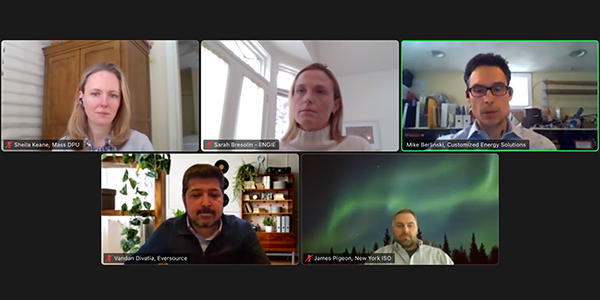Last September, FERC ordered RTOs and ISOs to open their markets to distributed energy resource aggregations. The commission said that the grid operators’ existing rules create participation barriers for aggregations in their capacity, energy and ancillary service markets.
While proponents have lauded Order 2222 for its intention, there are concerns regarding the lack of visibility and affordability of some DERs. There is also the question of whether the order intrudes on state jurisdiction, according to FERC Commissioner James Danly, who dissented on the ruling. (See FERC Opens RTO Markets to DER Aggregation.)
Attendees of a Northeast Energy and Commerce Association webinar Wednesday discussed these concerns and the impact of the order, as well as other potential roadblocks to DERs’ extensive deployment.
Order 2222 defines DERs as resources located on the distribution system or subsystem, or behind a customer meter. They include energy storage, thermal storage, intermittent generation, distributed generation, energy efficiency, and electric vehicles and their charging equipment. It requires RTOs and ISOs to allow DER aggregators to register as market participants under models that accommodate their physical and operational characteristics. Grid operators must set minimum size requirements for DER aggregations of no more than 100 kW.
Sarah Bresolin, director of government and regulatory affairs with ENGIE North America, said DERs are “a learning curve for everybody, and we’re all working fairly well to overcome the obstacles that we need to deploy these resources.”
Sheila Keane, assistant director of electric power at the Massachusetts Department of Public Utilities, said it is important to update the ISO-NE interconnection tariff and process.
“We’ve got a lot of these resources on our system, and the impacts are starting to roll up to the ISO level, so there’s been a lot more coordination and communication, and just figuring out those touchpoints,” Keane said. “We’re working through how to accommodate energy storage into our interconnection process in a meaningful way.”
Keane added that with new resources, even if they are small, comes the need for “significant upgrades to the distribution system.”
“[Upgrades] are expensive, and we don’t want that to be a barrier to continued deployment, so we’re looking at ways where we might enable some proactive investments in the distribution system rather than waiting for projects to trigger the need and sharing those costs among broader groups of customers.”
Vandan Divatia, vice president of transmission, policy and compliance at Eversource Energy, said the amount of DERs at some substations is greater than the transformer capacity.
“The number of resources behind the transformer is greater than the load that it was serving to a point where it can’t even send power back into the grid without upgrading the system,” Divatia said.
He added that it is “actually a fun challenge” where investment in the distribution system is necessary because it creates an “impact on our decarbonization goals, and it is going to create an impact on how the future grid evolves.”
“We just have to be as thorough as possible to make sure we don’t impact reliability through the whole transition, and we give enough of a heads up and expectation to these developers on what it’s going to take to interconnect,” Divatia said.
James Pigeon, manager of distributed resources integration for NYISO, said a principal benefit of DERs is “definitely” the addition of new types of resources adding to resilience while there is a challenge with size.
“In our model, we said anything down to 1 kW is acceptable as a participant in an aggregation, and there is a 100-kW aggregation minimum [with Order 2222],” Pigeon said. “Early on, one of our concerns was, what happens if we have thousands of these 100-kW aggregations that potentially slow down our dispatching system? That’s something we’ve been keeping an eye on as we expect the number of different resources that will be participating and having to solve for on a real-time basis grow.”
Impact of Order 2222
Mike Berlinski, director of emerging technologies for Customized Energy Solutions and webinar moderator, said that Order 2222 is “not overly prescriptive.”
“It doesn’t get into interconnection … and it doesn’t require that these ISO markets are going to provide enough money to make the project work, so you still have that challenge,” Berlinski said.
Bresolin was hoping that the order would address interconnection and models that would make participation in the capacity markets “a little bit easier for very small resources.”
Keane added that she is interested in voluntary coordination between state regulators and the RTOs, which she said is “appropriate and understandable.”
“We’re very much interested in establishing some sort of coordination,” Keane said. “I think that the trick that we have to think through in New England is we’re six different states [with] six different appetites or opinions on the order.”
Divatia said coordination is “going to be so important to make sure everyone gets involved” in implementing Order 2222, with the first compliance filing due in July.
Pigeon concluded that he is “just very excited to see where this plays out.”
“We’re seeing some of the biggest changes in 130 years in the electrical system, and I foresee it changing even more rapidly as we continue to progress,” Pigeon said. “I can only imagine what the next idea is going to be that looks crazy but turns out to be a reality.”


